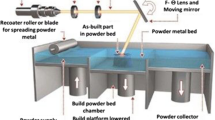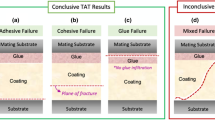Abstract
Establishing an accurate and effective stiffness model of the elastic contact surface is the basis for further modeling and analysis of machine tool dynamics. In this paper, a new elastic contact stiffness model is proposed that considers the bulk substrate deformation and modifies the Greenwood and Williamson microcontact model (GW model) of rough surfaces. Based on the Hertz contact theory and fixed-point iteration method, a single asperity contact model is created to analyze the effects of bulk substrate deformation and coating materials. To make the contact stiffness model more accurate and effective, two aspects are improved: One is to introduce the triangular distribution function to make the asperity heights distribution more consistent with the actual machined surface, and the other is to correct the defects in the micro-contact process. Comparing the finite element simulation results with the modal test data, the correctness of the proposed contact stiffness model is verified. The simulation results reveal the influence of distribution function, surface roughness and coating material on the contact characteristics of the joint surface.
Similar content being viewed by others
Abbreviations
- A0 :
-
Nominal contact area (mm2)
- A :
-
Real contact area (mm2)
- a 0 :
-
Contact area computed based on Hertz theory (mm2)
- a :
-
The lower limit of the trigonometric distribution
- b :
-
The upper limit of the trigonometric distribution
- c :
-
The mode of the triangle distribution
- D :
-
Fractal dimension
- d :
-
Separation based on asperity heights (mm)
- d n :
-
Dimensionless contact separation dlo)s
- d :
-
Critical contact separation (mm)
- d n :
-
Dimensionless critical contact separation d"lo)s
- E :
-
Effective elastic modulus of joint surface (GPa)
- E) a :
-
Elastic modulus of asperity (GPa)
- E ae :
-
Effective elastic modulus of asperity (GPa)
- E) b :
-
Elastic modulus of bulk substrate (GPa)
- E) be :
-
Effective elastic modulus of bulk substrate (GPa)
- F :
-
Normal load (N)
- f :
-
Contact force computed based on Hertz theory (N)
- G :
-
Fractal roughness factor (mm)
- g(z)n :
-
Exponential distribution function
- h(z) n :
-
Gaussian distribution function
- h a :
-
Asperity height (urn)
- K :
-
Overall contact stiffness (N/m)
- K n :
-
Normal contact stiffness (N/m)
- K j :
-
Tangential contact stiffness (N/m)
- ka :
-
Stiffness of asperity (N/m)
- kb :
-
Stiffness of bulk substrate (N/m)
- kn :
-
Normal stiffness computed based on Hertz theory (N/m)
- L :
-
Length of the sample (urn)
- mo :
-
Zero-order moment spectra (jm)
- m2 :
-
Second-order moment spectra
- m4 :
-
Fourth-order moment spectra (urn2)
- N :
-
Total number of asperities
- n :
-
Number of asperities in contact
- Po :
-
Maximum contact pressure (Pa)
- prob :
-
Contact probability
- R :
-
Curvature radius of asperity (urn)
- r :
-
Radial distance from the center of contact (urn)
- rb :
-
Radius of the contact area of substrate (urn)
- UZ(r):
-
Normal displacement of the contact surface
- δ:
-
Normal applied displacement (urn)
- δa :
-
Asperity deformation (urn)
- δb :
-
Bulk substrate deformation (urn)
- δ*:
-
Asperity deformation in the range of 0<n<1 (urn)
- v a :
-
Poisson’s ratio of asperity
- V b :
-
Poisson’s ratio of bulk substrate
- v :
-
Poisson’s ratio of joint surface
- σs :
-
Standard deviation of the surface heights distribution (urn)
- σ0 :
-
Standard deviation of the triangular distribution function
- z:
-
Asperity height measured from the mean of asperity heights (urn)
- zn :
-
Dimensionless height of asperity zlo)s
- k :
-
Ratio of the composite elastic modulus of the asperity to the bulk substrate
- ε:
-
Geometrical parameter about the size of the asperity.
- η:
-
Density of asperity (urn-2)
- μo :
-
Mean of the triangular distribution function
- φ(Zn):
-
Triangle distribution function
- τ:
-
Minimum sampling spacing of measuring instrument
- τ:
-
Gamma function
- ψ:
-
Scale parameter of the spectral density
- Φ:
-
Power spectrum function
- ωh :
-
The upper limit of the spectral bandwidth
- ωi :
-
The lower limit of the spectral bandwidth
References
J. P. Liao, J. F. Zhang, P. F. Feng, D. W. Yu and Z. J. Wu, Interface contact pressure-based virtual gradient material model for the dynamic analysis of the bolted joint in machine tools, J. of Mechanical Science and Technology, 30 (10) (2016) 4511–4521.
S. Li, H. L. Gao, Q. Liu and B. K. Liu, Dynamic modeling method of the bolted joint with uneven distribution of joint surface pressure, Asp Advances, 8 (3) (2018) 035116.
Y. Yu, Y. Cho, D. Lee and Y. C. Kim, Analysis of contact stiffness and bending stiffness according to contact angle of curvic coupling, Tribology and Lubricants, 1 (2018) 23–32.
M. Akhtar, A. Khajuria, V. S. Kumar, R. K. Gupta and S. K. Albert, Evolution of microstructure during welding simulation of boron modified P91 Steel, Physics of Metals and Metallography, 120 (7) (2019) 672–685.
J. Greenwood and J. P. Williamson, Contact of nominally flat surfaces, Proceedings of the royal society of London. Series A. Mathematical and Physical Sciences, 295 (1442) (1966) 300–319.
W. Chang, I. Etsion and D. B. Bogy, An elastic-plastic model for the contact of rough surfaces, J. of Tribology, 109 (2) (1987) 257–263.
Y. Zhao, D. M. Maietta and L. Chang, An asperity microcontact model incorporating the transition form elastic deformation to fully plastic flow, Trans. ASME, J. Tribology, 122 (1) (1999) 86–93.
L. Kogut and I. Etsion, Elastic-plastic contact analysis of a sphere and a rigid flat, J. of Applied Mechanics, 69 (5) (2002) 657–662.
L. Kogut and I. Etsion, A finite element based elastic-plastic model for the contact of rough surfaces, Tribology Transactions, 46 (3) (2003) 383–390.
M. Ciavarella, J. Greenwood and M. Paggi, Inclusion of “interaction” in the Greenwood and Williamson contact theory, Wear, 265 (5-6) (2008) 729–734.
M. B. Amor, S. Belghith and S. Mezlini, Finite element modeling of RMS roughness effect on the contact stiffness of rough surfaces, Tribology in Industry, 38 (3) (2016) 392–401.
D. Qiu, L. Peng, P. Yi and X. Lai, A micro contact model for electrical contact resistance prediction between roughness surface and carbon fiber paper, International J. of Mechanical Sciences, 124 (2) (2017) 37–47.
M. N. Balci and S. Dag, Mechanics of dynamic contact of coated substrate andrigid cylindrical ended punch, J. of Mechanical Science and Technology, 33 (5) (2019) 2225–2240.
X. Shi and A. A. Polycarpou, Investigation of contact stiffness and contact damping for magnetic storage head-disk interfaces, J. of Tribology, 130 (2) (2008) 021901.
A. I. Vakis, Asperity interaction and substrate deformation in statistical summation models of contact between rough surfaces, J. of Applied Mechanics, 81 (4) (2014) 041012.
T. Zhao and Y. Feng, Extended Greenwood-Wlliamson models for rough spheres, J. of Applied Mechanics, 85 (10) (2018) 101007.
J. Lee, A. Beheshti and A. A. Polycarpou, Rough surface normal nanocontact stiffness: experimental measurements and rough surface contact model predictions, J. of Applied Mechanics, 84 (3) (2017) 031006.
V. A. Eremeyev, On the effective properties of elastic materials and structures at the micro-and nano-scale considering various models of surface elasticity, Materials with Internal Structure, Springer, Cham (2016) 29–41.
S. Wen and P. Huang, Principles of Tribology, Wley (2012).
T. J. Truster, M. Eriten, A. A. Polycarpou, L. A. Bergman and A. Masud, Stabilized interface methods for mechanical joints: Physics-based models and variationally consistent embedding, International J. of Solids and Structures, 14–15 (2013) 2132–2150.
K. L. Johnson and K. L. Johnson, Contact Mechanics, Cambridge University Press (1987).
V. L. Popov, Contact Mechanics and Friction Physical Principies and Applications, Springer Berlin (2010).
C. D. Yeo, R. R. Katta and A. A. Polycarpou, Improved elastic contact model accounting for asperity and bulk substrate deformation, Tribology Letters, 35 (3) (2009) 191–203.
F. Jin, Q. Wan and X. Guo, Plane contact and partial slip behaviors of elastic layers with randomly rough surfaces, J. of Applied Mechanics, 82 (9) (2015) 091006.
M. Gonzalez-Valadez, A. Baltazar and R. Dwyer-Joyce, Study of interfacial stiffness ratio of a rough surface in contact using a spring model, Wear, 268 (3-4) (2010) 373–379.
A. Majumdar and B. Bhushan, Fractal model of elastic-plastic contact between rough surfaces, J. of Tribology, 113 (1) (1991) 1–11.
J. I. McCool, Relating profile instrument measurements to the functional performance of rough surfaces, J. of Tribology, 109 (2) (1987) 264–270.
H. A. Sherif and S. Kossa, Relationship between normal and tangential contact stiffness of nominally flat surfaces, Wear, 151 (1) (1991) 49–62.
J. Krolikowski and J. Szczepek, Assessment of tangential and normal stiffness of contact between rough surfaces using ultrasonic method, Wear, 160 (2) (1993) 253–258.
J. You and T. Chen, Statistical model for normal and tangential contact parameters of rough surfaces, Proceedings of the Institution of Mechanical Engineers, Part C: J. of Mechanical Engineering Science, 225 (1) (2011) 171–185.
Z Ming, G. Qintao, Y. Lin and Z. Baoqiang, Finite element model updating of jointed structure based onmodal and strain frequency response function, J. of Mechanical Science and Technology, 33 (10) (2019) 4583–4593.
Acknowledgments
This work was supported by National Natural Science Foundation of China Grant No. 51975449, Research Fund for Scientific Research Program Funded by Shaanxi Provincial Education Department Program No. 2018JM5066. The authors are grateful to other participants of the project for their cooperation.
Author information
Authors and Affiliations
Corresponding author
Additional information
Recommended by Editor Seungjae Min
Ling Li is a Professor of Mechanical and Electrical Engineering, Xi’an University of Architecture and Technology. He graduated from Beijing University of Technology with a Ph.D. in Mechanical Engineering. His research interests include machine dynamics, mechanical behavior of the bolted joints and interfaces of the critical structures, non-linear mechanics, and accurate design of machine tools.
Rights and permissions
About this article
Cite this article
Li, L., Wang, J., Pei, X. et al. A modified elastic contact stiffness model considering the deformation of bulk substrate. J Mech Sci Technol 34, 777–790 (2020). https://doi.org/10.1007/s12206-020-0126-3
Received:
Revised:
Accepted:
Published:
Issue Date:
DOI: https://doi.org/10.1007/s12206-020-0126-3




